Real life patient stories started seeping into the pharma lexicon well over a decade ago, on both a commercial and research level. The industry began turning to end users to discover how to create better drug delivery processes, clinical trial protocols, and marketing efforts, as well as to accurately understand the realities of the patient journey. Today, companies such as Merck, Boehringer Ingelheim, Amgen, Horizon, and Sunovion are using the patient perspective relative to marketing efforts and clinical trials.
Patient network companies such as WEGO Health and Inspire also foresaw the power in sharing patient stories and  the positive impact they could make on healthcare delivery. Each created vast patient communities that leverage the patient experience to help others cope with chronic, life-threatening, or rare conditions, and help pharma companies have regulatory-safe access to real-life patients. The stories shared by patients not only support fellow patients but also provide the industry with a window into the complexities of the patient journey.
the positive impact they could make on healthcare delivery. Each created vast patient communities that leverage the patient experience to help others cope with chronic, life-threatening, or rare conditions, and help pharma companies have regulatory-safe access to real-life patients. The stories shared by patients not only support fellow patients but also provide the industry with a window into the complexities of the patient journey.
“Pharmaceutical companies can — and do — use patient stories every day," says Jack Barrette, CEO, WEGO Health.
Mr. Barrette says patient opinion leaders (POLs) provide some of the most impactful stories because they have already built trust through relationships with the broader patient community.
“A POL’s earned credibility takes away any hint of the message being from a paid spokesperson, even though patient 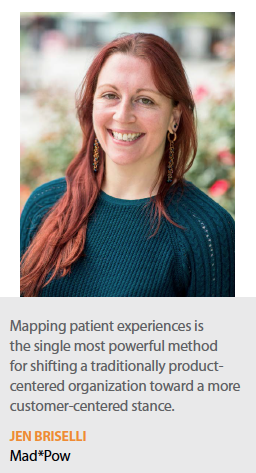 leaders are often compensated for their time, and should be," Mr. Barrette says.
leaders are often compensated for their time, and should be," Mr. Barrette says.
(Editor’s note: to read more about patient opinion leaders, turn to Patient Voices.)
Patient stories are a powerful way to educate physicians as well.
“A big opportunity for patient stories is in educating physicians; CME outfitters have built CME programs around patient leader stories, and physicians are responding really well to them," Mr. Barrette says.
Just last fall, Merck launched TV spots for Keytruda that featured the first real-life patient to appear in one of its ads. And although Amgen uses actors to represent some of its patients in its Enbrel TV commercials — except for Phil Mickelson — the campaigns were developed based on insights learned from real patients. And this spring, Boehringer Ingelheim launched a new patient website, morethanscleroderma.com, to supplement its More Than Scleroderma: The Inside Story campaign. The global initiative highlights the importance of understanding the inside story of each individual living with scleroderma, according to the company. Two other companies, Horizon and Sunovion, have developed opportunities for patients to share their stories and connect with others who are going through similar experiences. In turn, the companies get to truly understand what it means to be a patient, so that they can accurately tailor marketing messages and educational opportunities.
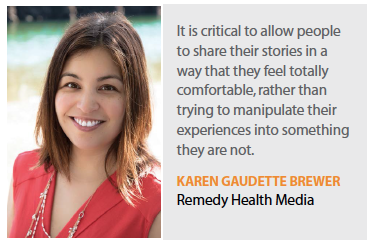 “We work closely with our advocacy partners to address multiple patient community concerns, including the need to create platforms to share patient experiences, because we know that authentic stories inspire and connect people in the most powerful, memorable, and transformative ways," says Maureen Sheltry, senior director, marketing and lead of Vision 2020 Patient Dimension, Sunovion Pharmaceuticals.
“We work closely with our advocacy partners to address multiple patient community concerns, including the need to create platforms to share patient experiences, because we know that authentic stories inspire and connect people in the most powerful, memorable, and transformative ways," says Maureen Sheltry, senior director, marketing and lead of Vision 2020 Patient Dimension, Sunovion Pharmaceuticals.
“Customized to reach unique audiences and address distinct community needs, many of our campaigns, including COPD Together and Talk About It! for epilepsy, were created to share individual and family experiences."
Many of Sunovion’s initiatives including COPD Together and Talk About It for Epilepsy! address distinct community needs. Recently, Sunovion collaborated with five advocacy partners on Beyond Silence, a Be Vocal: Speak up for Mental Health documentary, which is an example of authentic storytelling.
“The documentary features the stories of three very different people who share one common experience: their lives were transformed by speaking up for mental health," Ms. Sheltry says. “These individuals invited us into their most private lives, and it is because of their willingness to open up about their struggles, celebrations, triumphs, and setbacks that this film has forged a connection with audiences nationwide."
Not only do patient stories help form a connection with external audiences, but they also serve as motivation for Sunovion employees. The real life stories reinforce why the company’s employees come to work every day. “We believe it is essential that patient perspectives are included in all of our company-wide meetings and we encourage employees to engage with our advocacy partners directly through community-based events," Ms. Sheltry says.
According to Matt Flesch, executive director, product communications at Horizon Pharma, the more patient stories employees listen to, the better they get to know and understand patients.
“Listening to as many stories as we can helps us understand the various obstacles in the way of patients and their families so we can better meet their needs where appropriate," Mr. Flesch says. “Patient stories build trust and reputation because these communities see that we do much more than sponsor meetings and events — we show up and participate."
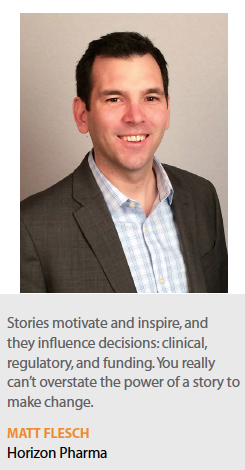 To meet patients and build relationships, Horizon employees attend local events and national conferences relating to the rare disease communities being addressed by its research efforts. Horizon also invites patients and their families to come to Horizon offices or to a work group setting off site. “Through these meetings, we hear many different stories and learn that no two stories are exactly alike, so there is no one-size-fits-all way to address their needs," Mr. Flesch says. “While there are certainly commonalities — diagnosis is a frequent challenge, as is finding specialists who understand an ultra-rare disease — there are so many unique aspects of each person’s journey."
To meet patients and build relationships, Horizon employees attend local events and national conferences relating to the rare disease communities being addressed by its research efforts. Horizon also invites patients and their families to come to Horizon offices or to a work group setting off site. “Through these meetings, we hear many different stories and learn that no two stories are exactly alike, so there is no one-size-fits-all way to address their needs," Mr. Flesch says. “While there are certainly commonalities — diagnosis is a frequent challenge, as is finding specialists who understand an ultra-rare disease — there are so many unique aspects of each person’s journey."
Horizon hosts several social media platforms for patients to share their stories, such as UCD in Common, CGD Connections, Cystinosis United, and RAREis. “It’s incredible to see what happens when patients share their stories," Mr. Flesch says. “The stories inspire, educate, and, ultimately, get people more informed and engaged."
Patient stories also bring value by incorporating the voice of the patient in every step of the product lifecycle.
According Neil Weisman, executive VP, patient recruitment and general manager, Continuum Clinical, pharma companies can and should use patient stories to improve their commitment to patient-centricity, moving beyond the use of patient-first mentalities as aspirational goals, and truly incorporating the voice of the patient in every step of the product lifecycle.
Collecting patient stories through advocacy group relationships and social listening will help ensure research and marketing messages are culturally competent, resonant, and eventually build the resources necessary to help empower patients to talk to their doctors about available treatment options, he says.
“The sooner patients and their stories are involved in the product development process, the more they will trust pharma to prioritize better health outcomes over profits," Mr. Weisman says. “None of us can know the implications 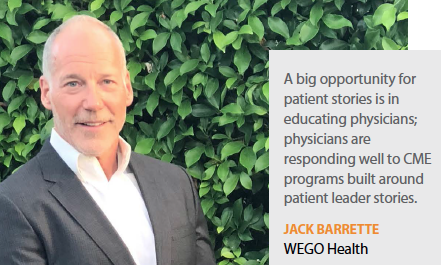 of living with a condition or the impacts of therapies on treating it unless it is part of our own reality. Patient storytelling is the most effective way to help us understand the physical and emotional consequences of disease. Patient perspectives ground us and should remind those of us in industry why we do what we do and help us refocus on what is most important to the success of a compound — healthier lives for us all. "
of living with a condition or the impacts of therapies on treating it unless it is part of our own reality. Patient storytelling is the most effective way to help us understand the physical and emotional consequences of disease. Patient perspectives ground us and should remind those of us in industry why we do what we do and help us refocus on what is most important to the success of a compound — healthier lives for us all. "
Patient stories are solid tools for patient education, and for helping patients not feel alone in their healthcare journey. By putting a human face on the condition and establishing a true-to-life context around the decisions to be made, brands can provide invaluable support to patients, family caregivers, and providers.
“Patient stories can add authenticity and humanity to a complex situation," says Aaron Sklar, VP, brand experience, Giant Creative Strategy.
“In addition to feeling fear and being overwhelmed when receiving a diagnosis, patients can be frustrated about having to master the necessary amount of information. Hearing from others who have gone through similar journeys is a very human way to understand the nuances of a diagnosis. These stories also serve to help frame and articulate questions patients wouldn’t have known to ask."
Anyone who has ever heard a good story can understand why storytelling is so effective in the healthcare space. Not only is it the most engaging and memorable way to make a point, but in a sea of fine print side effects, dense medical lingo, and inane TV spots, patient stories can grab and hold attention, Mr. Barrette says. True stories also bring authenticity, which is very important to patients.
“We have asked our members what makes a good story, and they invariably tell us it’s genuineness," he says. “A mobile phone video of a real patient beats an HD-quality actor portrayal any day; just as consumers have been trained to spot fake reviews on Yelp, they know a real patient when they see one."
Mr. Sklar agrees, noting that valuable messaging about health outcomes can be overshadowed by suspicion of corporate profit motives.
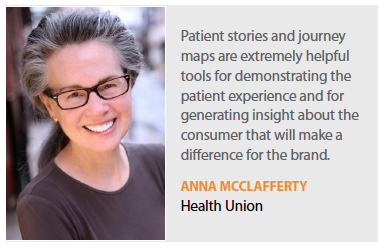 Patient stories amplify the human experience and communicate a brand’s impact in a way that establishes the tone of an organization as one that cares about the people it serves.
Patient stories amplify the human experience and communicate a brand’s impact in a way that establishes the tone of an organization as one that cares about the people it serves.
“One of the most challenging aspects of using patient stories is overcoming the perception that a pharma brand has cherry-picked only the most favorable representations of patient experiences," he says. “The audience is hungry for authenticity. The ideal collection of stories is representative of the whole experience — the good, the bad, and the ugly."
According to Anna McClafferty, senior VP, insights, Health Union, companies that truly understand their patients can discern a number of key factors, including whether a product or service meets important unmet needs, if shifts in patient mindset need to happen to support behavior change, if there are circumstances that need to exist for the patient to take action, and if there are information and interventions that must exist to support activating the patient.
“For any pharma company, the goal of understanding healthcare consumers intimately, including their experiences, perceptions, attitudes, beliefs, and actual behaviors, should be to meet patients where they are," she says. “This intimate understanding enables a company to build trust, gain traction, stay in tune, and engage with a stakeholder or customer. If companies take that understanding and apply it to everything they do, they can’t go wrong."
Being genuine and real is imperative in messaging, as often is seen in creative testing with people who have chronic conditions, many of whom are older, may be on disability, or constantly face stressful challenges. If patients are shown an ad featuring a beautiful person in an immaculate high-end kitchen, they think, ‘I don’t know who that person is; that doesn’t reflect my experience,’ " Ms. McClafferty says. “In this scenario, patients instantaneously recognize that a brand doesn’t know them, and nuances often matter as much as the obvious unmet needs. A deep understanding of and respect for the beliefs, emotions, and experiences of patients helps marketers hit their mark."
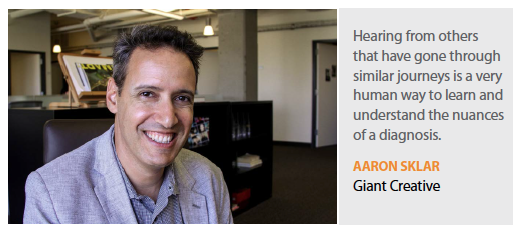 Horizon’s Mr. Flesch says his company has witnessed countless instances of patient storytelling fostering awareness and discussion that led to a more engaged and knowledgeable patient or caregiver. For example, Horizon created a video featuring one family’s story of their daughter’s urea cycle disorder — a rare and very challenging disease — and posted it to its UCD in Common Facebook page.
Horizon’s Mr. Flesch says his company has witnessed countless instances of patient storytelling fostering awareness and discussion that led to a more engaged and knowledgeable patient or caregiver. For example, Horizon created a video featuring one family’s story of their daughter’s urea cycle disorder — a rare and very challenging disease — and posted it to its UCD in Common Facebook page.
The video shows the family’s journey from the chaos of life-threatening symptoms, to finally achieving a correct diagnosis, to finding expert specialists. The video also showed the family’s experience meeting others with rare diseases at a national rare disease conference. The Facebook comments on this video showed an elevated understanding within the community on the value of being engaged, attending conferences, and continual learning.
“While it’s great to have studies to explain the burden and science of a disease, stories communicate so much more," Mr. Flesch says. “Stories motivate and inspire, and they influence decisions. They influence clinical trials, they influence the regulatory process, and they influence the allocation of funds for research and support. The power of a story to make change can’t be overstated."
The Power of a Good Story
Stories are powerful because our brains are hardwired to process information in story format — be it cultural norms, elder wisdom, or learnings gleaned from past experiences, says Jen Briselli, managing director of experience strategy and design, Mad*Pow.
“Storytelling even predates writing as a form of communication, and anthropologists and neuroscientists alike have agreed that stories represent the most powerful way to communicate human experiences," she says. “Modern experience strategy tools such as patient journey maps and storyboard narratives simply leverage the evolutionary foundations of our own cognitive and behavioral strengths to build common understanding and envision shared futures."
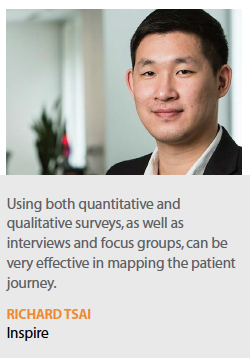 For example, in the field of major depressive disorder (MDD), which affects nearly 16 million American adults annually, medications do not always adequately relieve suffering. One alternative option for those with treatment-resistant MDD is called transcranial magnetic stimulation (TMS), a non-invasive, FDA-approved therapy. TMS works by stimulating brain areas using electromagnetic coils placed against the surface of the scalp that produce brief but powerful pulses of electromagnetic current, says Joseph Perekupka, VP of North American sales operations, Brainsway.
For example, in the field of major depressive disorder (MDD), which affects nearly 16 million American adults annually, medications do not always adequately relieve suffering. One alternative option for those with treatment-resistant MDD is called transcranial magnetic stimulation (TMS), a non-invasive, FDA-approved therapy. TMS works by stimulating brain areas using electromagnetic coils placed against the surface of the scalp that produce brief but powerful pulses of electromagnetic current, says Joseph Perekupka, VP of North American sales operations, Brainsway.
“Despite the fact that it has been proven safe and effective, TMS is widely misconceived," he says. “Patients unfamiliar with the treatment find it intimidating and scary. Sharing testimonials from those patients who have experienced dramatic improvements after using TMS treatment makes remission through TMS therapy feel less intimidating for those who are wary. These stories are one of the most impactful ways to deliver a message because they can help patients realize they are not alone. Physicians are very respected, but they cannot relate to the patient’s struggle."
Another example, involving oncology patients, is offered by Alex Seleny, senior director of portals and patient services, McKesson Specialty Health.
“Surviving cancer is about more than the medication a patient takes," he says. “It’s about the treatment journey and providing information and guidance that the patient needs to understand what it means to live with cancer. Breast cancer organizations have done a tremendous job of providing education and creating support groups that allow patients to share their experiences and learn more about solving their cancer-related problems."
Mr. Seleny also points out it is even more difficult for patients with rare forms of cancer or orphan diseases to connect and find others with a common situation. In these cases, patient stories are critical for education and to make sure that patients do not feel alone. Studies show that for patients who feel supported, ER visits decrease, depression decreases, and survival increases, compared with people who are not getting that same support, he says.
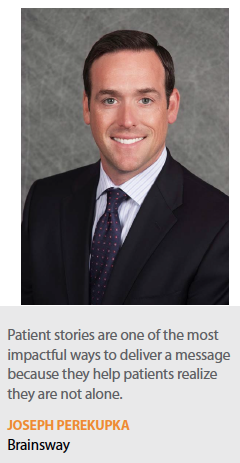 Lara DeSanto, Remedy Health Media’s Live Bold, Live Now writer, says that it’s critical to allow room for people to share their story in a way that they feel totally comfortable with, rather than trying to manipulate their experience into something it’s not.
Lara DeSanto, Remedy Health Media’s Live Bold, Live Now writer, says that it’s critical to allow room for people to share their story in a way that they feel totally comfortable with, rather than trying to manipulate their experience into something it’s not.
Creating the Journey
Patient journeys have evolved over the years and now typically include patient-centric details related to the emotional journey of receiving a diagnosis, the challenges associated with unsuccessful treatments, and the reality of hardships related to transportation, time lost from work, and family implications, says Tara Herington, VP, Cardinal Health Sonexus Access and Patient Support.
“The more patients and care partners are included in creating patient journeys, the more impactful the mapping becomes," she says. She cautions that although it may be tempting to create simplified patient journeys that show one pathway, the reality is that each patient has a unique journey. Effective journey maps show this complexity with dead-ends, diverging paths, and decision points.
More than anything, mapping the patient journey through effective storytelling helps illustrate the realities of life with a health condition. Ms. McClafferty at Health Union says solid journey mapping helps guide the best way to engage with certain patients and she has seen the results of how mapping can turn a campaign around.
“For the people on marketing teams and in creative agencies who are tasked with developing approaches to engage and communicate with consumers, patient stories serve as a way to walk a mile in someone else’s shoes," she says. “I’ve seen the difference patient stories can make in the before-and-after products from creative agencies."
Initially, she says, an agency comes up with an idea for the creative campaign, based on brand strategy and marketing objectives. But after the team has been exposed to patient stories and shown visuals about what the experience of a condition really means to people, the revisions are transformative. “Patient stories and journey maps are extremely helpful tools for demonstrating the patient experience and for generating insight about the consumer that will make a difference for a brand," Ms. McClafferty says.
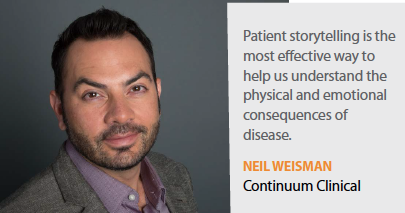 Karen Gaudette Brewer, HealthCentral executive editor, Remedy Health Media, offers an example of how mapping a patient’s journey provides multiple touchpoints to connect with the desired audience. Live Bold, Live Now is a Remedy-wide initiative consisting of a multi-media experience with engaging content and tools designed to influence treatment decisions and inspire patients to take action to live their best life. Tracy Martin is a rheumatoid arthritis Live Bold, Live Now hero who recently set a record for endurance kayaking on the waters of the Great Lakes. “We mapped her journey back to childhood, watching her grandmother grapple with RA and how it was treated in that era, to current day, where granddaughter Tracy is able to crush a world record due to the dramatic strides made with treatments for this formerly crippling disease," Ms. Brewer says. “All of those elements allow us and pharma brands to share a story like this in a multitude of conversations — during grandparents’ day, the Olympics, disability rights advocacy days, and conversations about public funding for medical research."
Karen Gaudette Brewer, HealthCentral executive editor, Remedy Health Media, offers an example of how mapping a patient’s journey provides multiple touchpoints to connect with the desired audience. Live Bold, Live Now is a Remedy-wide initiative consisting of a multi-media experience with engaging content and tools designed to influence treatment decisions and inspire patients to take action to live their best life. Tracy Martin is a rheumatoid arthritis Live Bold, Live Now hero who recently set a record for endurance kayaking on the waters of the Great Lakes. “We mapped her journey back to childhood, watching her grandmother grapple with RA and how it was treated in that era, to current day, where granddaughter Tracy is able to crush a world record due to the dramatic strides made with treatments for this formerly crippling disease," Ms. Brewer says. “All of those elements allow us and pharma brands to share a story like this in a multitude of conversations — during grandparents’ day, the Olympics, disability rights advocacy days, and conversations about public funding for medical research."
According to Richard Tsai, VP of marketing and communications at Inspire, using both quantitative and qualitative surveys, as well at interviews and focus groups can be very effective in mapping the patient journey. Unobtrusive observation of the targeted patient population — a social listening process where one can anonymously and longitudinally follow through the various troughs and crest of their experience and potentially explore their interaction with other stakeholders along the journey — is also extremely valuable.(PV)
~~~~~~~~~~~~~~~~~~~~~~~~~
Patients’ Voices: The Journey
 Howard Chang
Howard Chang
Psoriasis Foundation Volunteer
Psoriasis Patient
@hchang316
The patient story authentically and deeply touches other patients, many of whom might otherwise feel isolated. People with skin conditions in my community face the temptation to hide. They can hide their skin under clothes, hide their fatigue behind weary faces, and hide their disappointment in a telling half-smile. The lack of connection with others intensifies that feeling of being the only one in the world with a condition.
I started my psoriasis column on Everyday Health more than 10 years ago. I ended my first entry with the hope that it could be a tool to contribute in a small way to the need to connect and communicate about that part of our lives that so often stays under wraps: psoriasis. The overwhelming response over the years is one of gratitude for sharing a deeply personal story with them.
That authenticity and connection extends beyond effectively bringing fellow patients out from isolation. Real-life stories communicate in a way that allows the hearer to engage their own unique circumstances with another’s story. Hearing experiences from fellow patients about healthcare providers, insurance representatives, or therapies and medications open up possibilities and new ideas for me and my decision-making.
Furthermore, patient storytelling impacts caregivers and providers by giving them a glimpse into the patient’s experience. No one can completely walk in another’s shoes, but the ability to empathize with others starts with listening to their stories. If patients don’t tell those stories, they miss out on the opportunity to inform others how it is to walk in their shoes.
 Lilly Stairs
Lilly Stairs
Patient Advocacy Clara Health
Autoimmune disease
@LillyStairs
Patient opinion leaders are essential not only to the patient ecosystem, but the healthcare ecosystem as a whole. POLs represent the collective voice of their communities and are well equipped to share that insight with pharma, insurance, and digital health companies.
The communication loop comes full circle as POLs then share their experiences working with pharma back with their engaged communities, helping to foster a greater understanding of up and coming treatment options and resources available to the broader patient population.



















